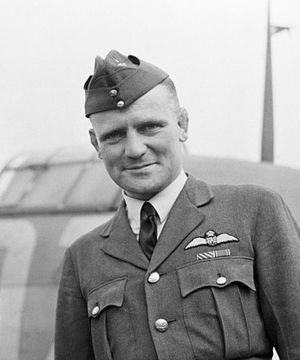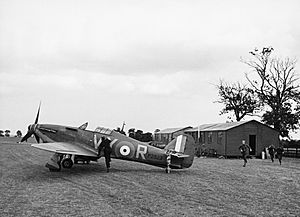Victor Beamish facts for kids
Quick facts for kids
Victor Beamish
|
|
|---|---|

Wing Commander FV Beamish
|
|
| Born | 27 September 1903 Dunmanway, County Cork, Ireland |
| Died | 28 March 1942 (aged 38) English Channel, near Calais, occupied France |
| Allegiance | United Kingdom |
| Service/ |
Royal Air Force |
| Years of service | 1921–1933 1937–1942 |
| Rank | Group Captain |
| Service number | 16089 |
| Commands held | RAF Kenley (1942) RAF Debden (1941) RAF North Weald (1940–41) No. 504 Squadron RAF (1938–40) No. 64 Squadron RAF (1937–38) |
| Battles/wars | Second World War |
| Awards | Distinguished Service Order & Bar Distinguished Flying Cross Air Force Cross Mentioned in Despatches |
Group Captain Francis Victor Beamish (September 27, 1903 – March 28, 1942) was a brave Royal Air Force (RAF) fighter pilot. He was known as a "flying ace" because he shot down many enemy planes during the Second World War. He fought in the famous Battle of Britain and kept leading important missions until he died in action in 1942.
Contents
Early Life and Beginnings
Francis Victor Beamish was born on September 27, 1903, in Dunmanway, County Cork, Ireland. His parents were Francis George and Mary Elizabeth Beamish. He went to school at Coleraine Academical Institution.
Joining the Royal Air Force
Victor Beamish started his journey in the RAF on September 14, 1921. He joined the RAF College, Cranwell, which is a special school for future pilots. After finishing his training in August 1923, he became a pilot officer.
He then joined different squadrons. He worked with the army in Squadron 4 and later went to India with No. 31 Squadron RAF and No. 60 Squadron RAF. He became a flying officer in 1925.
A Talented Sportsman
Beamish was not just a pilot; he was also a great athlete! He played rugby union for several famous teams, including Harlequins and Leicester. He also played for the RAF team. His brothers, George, Charles, and Cecil, were also RAF officers and good sportsmen.
Health Challenges and Return to Service
In 1933, Beamish faced a health challenge. He had to leave the RAF because he got sick with tuberculosis. But he didn't give up! After recovering, he worked in civilian jobs for a few years.
In 1937, he was able to rejoin the RAF as a flight lieutenant. He was given full flying status again. He then took command of No. 64 Squadron RAF in December 1937. He received the Air Force Cross in 1938 for his excellent work.
Wartime Service
When World War II began, Beamish was ready. He took command of No. 504 Squadron RAF in September 1939. He was recognized for his service in February 1940. He was promoted to Wing Commander on March 1, 1940. Soon after, he took charge of RAF North Weald air base.
Battle of Britain Hero
Wing Commander Beamish was a very active pilot. He flew many missions himself. During the Battle of Britain in 1940, he showed incredible bravery.
- On June 18, 1940, he shot down two enemy Messerschmitt Bf 109 fighters.
- On July 12, 1940, he shot down a Dornier Do 17 bomber.
- He also damaged or probably destroyed many other enemy planes. These included Junkers Ju 88 bombers, Messerschmitt Bf 110 heavy fighters, and Junkers Ju 87 dive bombers.
His courage and leadership were an inspiration to everyone. He was awarded the Distinguished Service Order (DSO) on July 23, 1940. This award is given for outstanding leadership in battle.
More Awards and Continued Fighting
Beamish continued to fight bravely. He received the Distinguished Flying Cross (DFC) on November 8, 1940. This award is for acts of courage during air operations. His citation said he had "displayed exceptional keenness" and "coolness and courage."
Even after being promoted to Group Captain, he kept flying missions. He was awarded a Bar to his Distinguished Service Order on September 2, 1941. This meant he had earned the DSO a second time.
In January 1942, Beamish took command of RAF Kenley. He flew more often with his squadrons. On February 12, 1942, he and another pilot spotted German warships. Their report helped the RAF plan attacks on the enemy fleet.
He continued to score victories, shooting down a Focke-Wulf Fw 190 on March 9, 1942. He claimed another Fw 190 and a Bf 109 on March 26, 1942.
Killed in Action
On March 28, 1942, Group Captain Beamish was leading his squadron. They were flying near Calais, France. They met a group of enemy Bf 109s and Fw 190s. In the fierce fight, Beamish's plane was hit by a Bf 109. He was last seen flying into a cloud near Calais. He died that day, fighting for his country.
Awards and Recognition
- Air Force Cross: January 1, 1938
- Mentioned in Despatches: February 20, 1940
- Distinguished Service Order: July 23, 1940
- Distinguished Flying Cross: November 8, 1940
- Bar to the Distinguished Service Order: September 2, 1941


